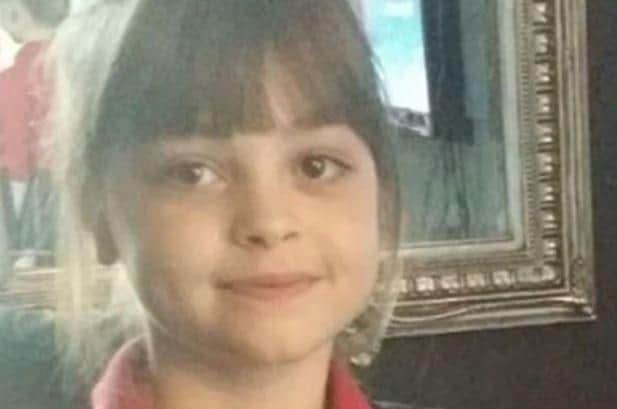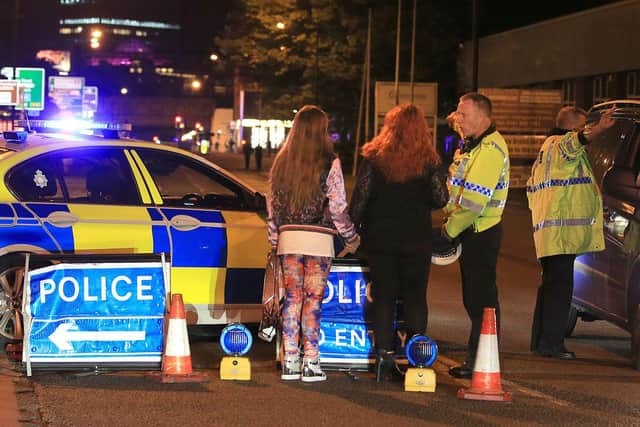Manchester Arena attack: Inquiry slams failures of emergency services on night of bombing
and live on Freeview channel 276
Care worker John Atkinson, 28, was six metres away when the explosion went off in the City Room foyer of the venue at the end of an Ariana Grande concert on the evening of May 22, 2017.
A member of the public used his wife’s belt as a tourniquet on Mr Atkinson’s leg as he lay bleeding in agony on the City Room floor for up to 50 minutes, during which time he told a police officer: “I’m gonna die.”
Advertisement
Hide AdAdvertisement
Hide AdOnly three paramedics entered the City Room on the night and none were seen to attend or assist Mr Atkinson, before he was carried on a makeshift stretcher to a casualty clearing area where he later suffered a cardiac arrest – one hour and 16 minutes after the blast.


On Thursday, Manchester Arena Inquiry chairman Sir John Saunders delivered a scathing report on the response of the emergency services.
He said: “Significant aspects of the emergency response on 22nd May 2017 went wrong. This should not have happened.
“Some of what went wrong had serious and, in the case of John Atkinson, fatal consequences for those directly affected by the explosion.”
Advertisement
Hide AdAdvertisement
Hide Ad

Four victims from Lancashire were killed in the bombing including Blackpool mum and school receptionist Jane Tweddle, 51; Georgina Callander, 18, from Hesketh Bank; Ribble Valley mum-of-three Michelle Kiss, 45, and the terror attack's youngest victim, Saffie Roussos, eight, from Leyland.
Lawyers for Saffie-Rose Roussos had submitted during the inquiry that her injuries were potentially survivable.
Sir John said it was “highly unlikely” Roussos would have survived her injuries, with “only a remote possibility she could have survived with different treatment and care.”
He concluded: “In the case of Saffie-Rose Roussos, it is highly unlikely that she could have survived her injuries. There was only a remote possibility she could have survived with different treatment and care.
Advertisement
Hide AdAdvertisement
Hide Ad

“I do not consider that the evidence enables me to say she had absolutely no chance of survival if the most comprehensive and advanced medical treatment had been initiated immediately after injury.
“I make clear what I am postulating is a remote possibility of survival. On the evidence that I have accepted, what happened to Saffie-Rose Roussos represents a terrible burden of injury. It is highly likely her death was inevitable even if the most comprehensive and advanced medical treatment had been initiated immediately after injury.”
The initial command of the incident was taken by Greater Manchester Police’s force duty officer, Insp Dale Sexton, but he “quickly became overburdened by the number of tasks he had to undertake”, the report found.
Sir John said: “This had a direct impact on the effectiveness of the emergency response. It affected who received information, what resources were made available and the decisions of other commanders.”
Advertisement
Hide AdAdvertisement
Hide Ad

Following erroneous reports of gunshots, Insp Sexton declared Operation Plato – a pre-arranged plan for a suspected marauding terrorist – but he “overlooked” telling other emergency services.
“It affected the ability of the emergency services to work together by jointly understanding the risks,” said Sir John.
“In the first quarter of an hour after the attack and thereafter, there was substantial confusion over the location of an RVP (rendezvous point). Each emergency service chose its own.”
Fire crews took more than two hours to attend the incident after station manager Andy Berry chose to mobilise resources three miles from the Arena amid fears over safety.
Advertisement
Hide AdAdvertisement
Hide AdSir John said: “The effect… was that the fire appliances at Manchester Central Fire Station drove away from, not towards, the incident. While driving away, the Manchester Central fire appliances drove past ambulances travelling in the opposite direction.”
He said that North West Ambulance Service operational commander Dan Smith made an “error” in not sending ambulances to meet at Manchester Central Fire Station rather than going directly to the scene.
Mr Smith also wrongly believed non-specialist paramedics should not be deployed into the City Room.
By 10.50pm the City Room was a “cold zone”, said Sir John, where it was assessed there was no immediate threat to life from an armed terrorist.
Advertisement
Hide AdAdvertisement
Hide AdHe said that did not mean the City Room was entirely safe but a police chief had deemed it “safe enough” for non specialist emergency responders and members of the public to be in.
He said: “Not only should this have been the view across the emergency services, based on the available information, but it was in fact correct, as is now known for certain.”
As the post-attack “golden hour” ended, the emergency response had failed to achieve effective evacuation.
Just after midnight there were still 36 casualties waiting to go to hospital, with the last casualty departing at 2.50am on May 23.
Advertisement
Hide AdAdvertisement
Hide AdSir John said: “To those who experienced it, this period of time will have seemed interminable. It must not happen again.”
He said the evidence was “conclusive” there was no possibility that 20 of the 22 victims could have survived the “murderous actions” of Salman Abedi, referred to sparingly by his initials in the 874-page report.
Sir John’s first report on security issues at the Arena was issued last June and highlighted a string of “missed opportunities” to identify Abedi as a threat before he walked across the City Room and detonated his shrapnel-laden device.
The third and final report will focus on the radicalisation of Abedi and what the intelligence services and counter-terrorism police knew, and if they could have prevented the attack. It will be published at a later date.
